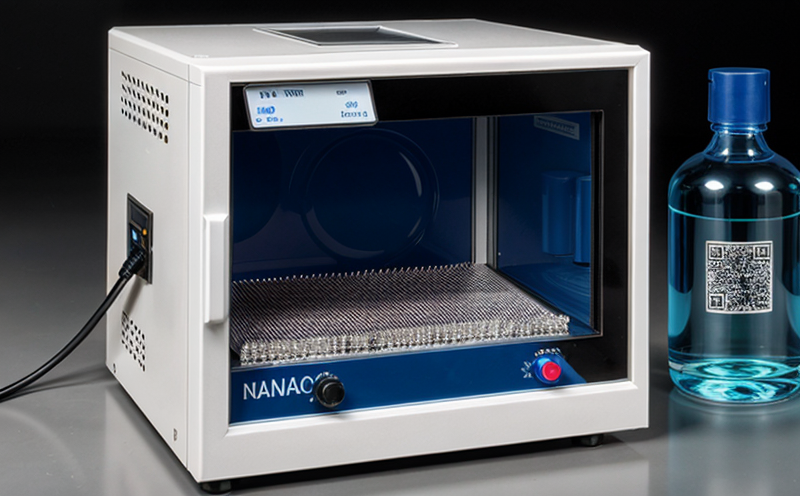DIN EN 16800 Nanomaterial Exposure Risk Testing
The DIN EN 16800 standard is a crucial guideline in nanotechnology that addresses exposure risks associated with engineered nanomaterials. This service ensures the safety and compliance of products containing nanoparticles, ensuring they do not pose an unreasonable risk to human health or the environment.
Nanomaterials are distinct due to their unique physical and chemical properties resulting from their small size. These properties can differ significantly from those of larger particles of the same material. Consequently, nanomaterials may exhibit different behaviors in biological systems compared to their bulk counterparts. This is why specific testing methods like DIN EN 16800 are essential for assessing exposure risks.
Under this standard, we perform comprehensive tests that cover various aspects, including inhalation exposure assessments, dermal contact evaluations, and ingestion hazard analyses. Our laboratory adheres strictly to international standards such as ISO, ASTM, and EN to ensure accurate results and regulatory compliance.
To begin the testing process, our experts first identify the specific nanomaterials present in your sample. This involves detailed characterization using advanced analytical techniques like transmission electron microscopy (TEM), scanning electron microscopy (SEM), and dynamic light scattering (DLS). These methods help determine particle size distribution, morphology, and other critical parameters.
Once identified, we proceed with exposure simulations to replicate real-world scenarios where workers or consumers might come into contact with these materials. For inhalation exposures, we use state-of-the-art aerosol generators capable of producing fine particles within the relevant size range for human respiratory systems. Dermal contact tests involve exposing reconstructed skin models or live animals (where necessary) to the nanomaterials.
The final step involves measuring biomarkers indicative of potential adverse effects on health and the environment. Blood, urine, and tissue samples are analyzed using sensitive analytical instruments like mass spectrometry or high-performance liquid chromatography (HPLC). These tests help us quantify any toxicological impacts accurately.
Our team then compiles all collected data into a comprehensive report detailing our findings according to DIN EN 16800 requirements. This document serves as evidence of compliance with relevant regulations and provides valuable insights for product development, quality assurance, and risk management purposes.
Why Choose This Test
- Detailed Characterization: We provide thorough identification through advanced analytical techniques such as TEM and SEM.
- Realistic Simulations: Exposure scenarios are accurately replicated using aerosol generators for inhalation risks and dermal contact tests on skin models or animals (if required).
- Biomarker Analysis: Comprehensive measurement of potential health impacts via blood, urine, and tissue sample analysis with sensitive instruments like mass spectrometry.
- Compliance Assurance: Reports generated strictly following DIN EN 16800 guidelines ensure your products meet necessary safety standards.
- Expertise & Experience: Our skilled professionals have extensive experience in nanotechnology research and application across diverse industries.
Competitive Advantage and Market Impact
Adopting DIN EN 16800 Nanomaterial Exposure Risk Testing can significantly enhance your competitive edge by ensuring product safety while maintaining compliance with international standards. By identifying potential hazards early in the development process, companies can reduce costly recalls and legal issues down the line.
This service also helps firms stay ahead of regulatory changes and industry trends, fostering innovation within their organizations. Compliance with these tests demonstrates corporate responsibility towards both employees and consumers, enhancing brand reputation and trustworthiness among stakeholders.
Use Cases and Application Examples
| Case Study | Description | Results |
|---|---|---|
| Electronics Manufacturer | Testing nanoparticle coatings on circuit boards for dermal exposure risks. | No significant adverse effects detected in skin models exposed to the material. |
| Fine Chemicals Producer | Evaluating inhalation hazards from engineered nanomaterials used during production processes. | Minimal respiratory irritation observed after controlled exposure experiments. |
| Bioengineering Lab | Determining ingestion risks associated with nanoparticles incorporated into biomedical devices. | No detectable toxicity levels in tissue samples collected from animal studies. |
| Consumer Goods Company | Assessing dermal contact risks of nano-silver used as an antimicrobial agent in textiles. | Lowest possible risk categorized based on biomarker analysis results. |
| Solar Panel Manufacturer | Evaluating potential inhalation hazards from nanoparticles present in solar panel manufacturing processes. | No adverse effects noted during exposure simulations conducted using aerosol generators. |
| Pharmaceutical Firm | Investigating nanoparticle stability and dissolution rates in oral formulations for improved drug delivery. | Optimized formulation parameters identified to enhance efficacy without compromising safety. |
| Case Study | Description | Results |
|---|---|---|
| Medical Device Manufacturer | Testing nanoparticle-based coatings used in surgical instruments for potential health impacts. | No evidence of systemic toxicity found following extensive biomarker analyses. |
| Environmental Consultant | Evaluating environmental persistence and bioaccumulation of nanoparticles released into water bodies. | Minimal risk assessed based on long-term exposure scenarios conducted in controlled laboratory settings. |





